
Over recent days, commentators have been parsing the meaning of the breakdown of the US–DPRK summit last Friday. Most of the speculation turns upon the question of who wins and who loses from the busted flush in Hanoi. Should we be grateful that President Donald Trump chose to walk rather than tie the US to a bad outcome? Does Kim Jong-un regret overbidding his hand? Are both leaders now bitter, resentful and reluctant to invest further time and political capital in each other? Is the hope of North Korean denuclearisation dead? If so, what does that mean for other, more unsettling, options? Is Japan the real regional winner from the summit’s collapse?
Those are all serious questions, but we should start by understanding what the Trump–Kim summits really are. They’re not like the summits of yesteryear, when heads of government of great powers arrived—usually at the end of a gruelling climb by each side’s Sherpas—to celebrate the conquest of another diplomatic Everest. The format has been adapted here to serve a specific purpose: to allow direct discussion between a superpower and a rogue regime on an issue of great importance to both, but one wrapped in layers of complexity. Add in the fact that two capricious leaders are simultaneously the architects of the process and its lead actors, and it’s hardly surprising that the summits faced some daunting challenges.
The issue is not simply the denuclearisation of North Korea. Critics are perfectly right that denuclearisation isn’t likely to be a near-term outcome of the summits. Indeed, it might not even be a long-term outcome. The core objective of the summits is a double-barrelled one: to rein in Pyongyang’s nuclear capabilities, and to ‘normalise’—perhaps that should read ‘make more normal’—North Korea. Both barrels make individual sense. A North Korean nuclear program that remains essentially corralled at the level it was between, say, 2006 and 2016, is much less of a threat to the world than one which builds on the astonishing achievements of 2017. And a more normalised North Korea is one which is likely to be seen both as a credible interlocutor and a better fit for its regional neighbours.
What happened in 2017 that was so unacceptable? Simple. Pyongyang successfully tested both a thermonuclear device and two different models of an intercontinental ballistic missile. In doing so, Kim made North Korea’s nuclear program globally unacceptable and not just a regional pain in the ass. Those tests do not mean that Pyongyang has today the capability to target the continental US with nuclear weapons. The ICBMs have only ever been tested on highly lofted trajectories—unlike the North’s intermediate-range missiles, which have actually been tested to range.
Over at 38 North, Michael Elleman argues that Pyongyang can only have a reliable ICBM capability by sustained testing. Based on the history of ICBM development in the US, the USSR and China, North Korea will probably require 10 to 20 tests of each different missile variant to have a reliable system. Currently, the Hwasong-14 has been tested twice and the Hwasong-15 only once. Designing a warhead is an interactive process. Yes, the regime has shown the ability to build an advanced two-stage warhead. Once North Korea is confident it has a reliable missile, though, it will have a proper understanding of the stresses the warhead needs to survive to detonate at the other end.
So, Pyongyang doesn’t yet boast proven ICBM capabilities. It might never do so, since it seems the ‘fire and fury’ moment has exercised some cautionary discipline upon the North Korean strategic mind.
But here’s the thing: it’s also exercised a similar discipline upon the American strategic mind. And that discipline has been the key driver of the broader summit process. The Singapore and Hanoi summits now sit at the heart of American attempts to bring North Korea into the current century. The end point of the summit process is not merely a constrained nuclear North Korea; it’s a North Korea which has the economic vitality and security confidence to allow it to relegate its nuclear capabilities to the background.
Whether Trump himself has any such goal in mind is one of Donald Rumsfeld’s ‘unknown unknowns’. Those with long memories will argue that such strategic good sense scarcely seemed to be the motivating factor behind Trump’s sudden agreement to the Singapore summit. Still, it would be nice to believe that he has the patience and foresight to work towards that end. It’s also possible that he might plump instead for short-term benefits, like signing a peace treaty or saving money by ending US military commitments to South Korea.
But remember what Joel Wit observed in 2016: President Barack Obama’s policy of ‘strategic patience’ had left US foreign policy towards North Korea ‘trapped in no-man’s land’. Washington was in bad need of a policy that would let it get back into the game in Northeast Asia.
We don’t believe Trump understood that he would be meeting Kim once a year for the remainder of his presidency. But he probably will be—because the stakes are so high, and there are few alternative pathways. The Americans want badly to halt and roll back North Korea’s long-range missile developments, and to stop the further production of fissile material. But key to doing so is Trump always having a broader agenda than nuclear weapons—while not giving up on steps that reduce, and eventually end, North Korea’s capacity to threaten the US and its allies in North Asia. That’s part of the normalisation process. And normalisation never happens overnight.
We’re all feeling our way across the river here, folks. Some summits will go better than others. Don’t sweat the small stuff.

